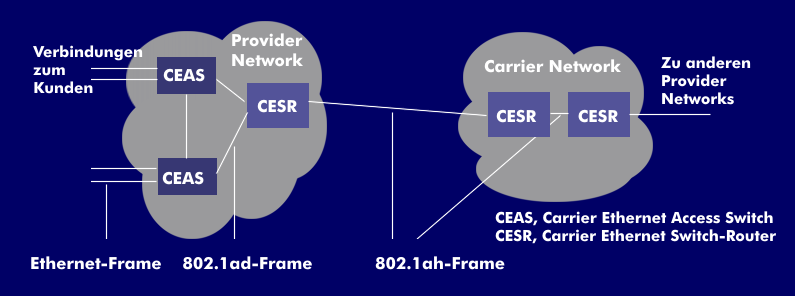provider bridge (802.1ad) (PB)
Provider Bridges (PB) are bridges with which scaling is performed in Carrier Ethernet. These provider bridges, standardized in IEEE 802.1ad, and the provider backbone bridges( PBB) specified in 802.1ah, enable service providers to scale services and virtually distribute customer traffic using Ethernet technology.
The 802.1ad standard was developed with the deployment of Ethernet in city networks in mind. The Provider Bridge frame is an Ethernet frame that is extended in Carrier Ethernet Access Switches( CEAS) to include an additional 4-bytedata field for VLAN tagging, which is used for tunnelingdata packets through the provider network. Provider networks may also contain Carrier Ethernet Switch Routers( CESR) that switch or encapsulate the PB data packets into PBB data packets, Provider Backbone Bridges (PBB). In Carrier Ethernet, the CESRs provide transport of the data packets between the provider networks and in the carrier networks.
With the extended provider bridge frame, the service provider can perform tagging without considering the customer tag. The inserted VLAN tag for the VLAN identifier( VID) is the S-VID, which stands for service provider. In contrast, the existing VLAN identifier is called the C-VLAN tag, for Customer (C-VID). Both VLAN tags have 2 bytes each.
Since the provider bridge technology is limited in the number of customer-specific VLANs, namely to a maximum of 4,096, the technology was developed with provider backbone bridges (PBB). For this purpose, the standardization committees of 801.2ah developed a 16- byte header extension for the frame used in Provider Backbone Bridges.


-nach-IEEE-802-1ad.png)